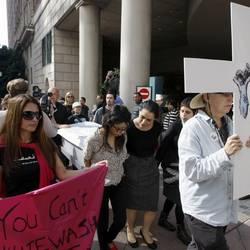By Giacomo Galeazzi
Vatican Insider
November 20, 2011
vaticaninsider.lastampa.it/en/homepage/world-news/detail/articolo/stati-uniti-us-estados-unidos-chiesa-church-iglesia-10109/
 |
| American catholics |
Two million «flee» from Rome. Abuse-effect: a bleeding of faithful in the United States. 3% of U.S. Catholics left the Church because of the scandal of pedophile priests, according to a study conducted by Daniel M. Hungerman for the University of Notre Dame. And those who benefit the most from this crisis in American Catholicism is the Baptist denomination. Guido Mocellin, in the magazine of the Dehonian Fathers "Il Regno" warned of a «credibility crisis» in the U.S. Church. The fault is above all in the line of omissive conduct applied by the episcopate before the «zero tolerance» imposed by Benedict XVI. For years the American bishops have in fact tried to cover guilty priests by dealing with the compensation of victims outside the courtroom, instead of reporting all cases they became aware of to the legal authorities and instead of removing the accused from their pastoral duties. And it was late for the public admission made by the bishops of their previous failure or inadequacy in the face of sexual violence against minors committed by priests.
The feeling that «the Catholic Church was more concerned with defending its priests rather than its children; that the bishops preferred to spend billions of dollars in private compensation for damages rather than publicly acknowledging their responsibilities and those of the priests under their jurisdiction; which in essence so flagrantly betrayed the trust that under many aspects the Catholic ecclesiastical institution has earned in the country, placing the legal and financial aspects before the pastoral ones, all this is generating, particularly in the everyday "American Catholic", painful feelings: sadness, disgust, anger, frustration, confusion, embarrassment».
It is as though collectively, in the relationship between the Church as an institution and the Church as the people, «the dynamics that took place in each of the violence between the priest and the child who became his victim was reproduced». The wave of scandals produced by the current drain of two million faithful in the United States was anticipated by two serious precedence. In 1985 with the case of the Diocese of Lafayette, based upon which the bishops began to become aware of the problem, and in the early nineties when a former priest, J. Berry, published the book «Lead us not into temptation: Catholic priests and sexual violence against minors». «What creates confusion among the public is not so much the news itself of sexual misconduct of a number of priests against minors: other institutions, and specifically other churches are no less affected by the phenomenon than the Catholic Church- is Mocellin's analysis - The percentage of priests authors of this behavior, which are estimated between 3% and 6%, does not differ from the overall percentage of the perpetrators of child sexual abuse in the totalpopulation ».
Rather, American public opinion (and the share of Catholics it contains) is seriously alarmed by the figures which clearly show that many bishops have tried to cover the responsibilities of their priests by failing to report them to the legal authorities, and negotiating with the victims for compensation in cash in exchange for silence, and lastly limiting the canonical penalty to a transfer to another parish, after brief psychiatric therapy. "As if their moral and religious approach could eventually get what medicine declared could not be achieved," says Mocellin, "It is not very comforting to know that the Bishops' Conference had addressed the problem in time: requesting already in 1985 a first, ample dossier, dedicating the meeting in June 1992 to this issue and issuing a set of guiding principles, and in 1993 (after an encounter with the Holy See and a letter of John Paul II) by establishing a Commission Ad hoc at the Conference, and lastly by publishing in 1995, "Walking in the light", generally dedicated to sexual abuse on child but also aware of the specific responsibilities of the clergy in this respect". It is likely that "all the indications emerging from this work could contain and manage the phenomenon, but they were not binding for each bishop and thus each bishop acted as he saw fit". The questions which in the United States cross the ecclesial community are in fact very specific questions, such as the procedure for selecting candidates for the priesthood and, more broadly speaking, the possibility that the Latin Church open the priesthood to married men as well (if not women), "not because sexual abuse on minors can be interpreted as an expression of a sexual deviation which, if possible, would "normally" turn to adult women (this reading would not be correct), but because the obligation of celibacy would end up restricting the list of candidates for the priesthood to sexually immature or homosexual individuals".
So "there is no doubt that, unexpectedly, even for the European observer, the Church of the United States was puzzled by a problem where, for the particular context of the society they live in and for the parallel tests of vitality which in recent years, we would have expected them in the forefront". The defensive behavior shown, highlights the scholar, "is basically closer to self-understanding of pre-councilor system, wary of public opinion, jealous of the social prestige of his paintings to the point of wanting to defend them even against the evidence of facts. The comparison suggested by a psychologist at Loyola University in Chicago with the Confederate general, who after the defeat in the Civil War did not want to accept that "their world was finished," is very American, but very effective".
Any original material on these pages is copyright © BishopAccountability.org 2004. Reproduce freely with attribution.